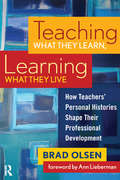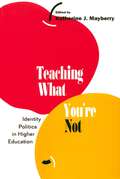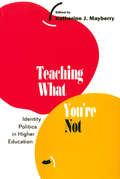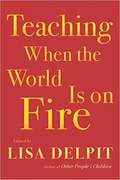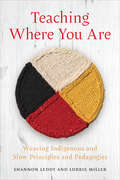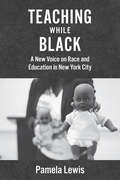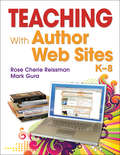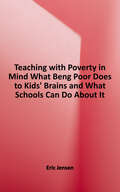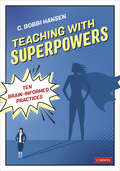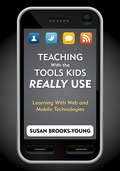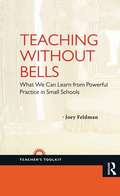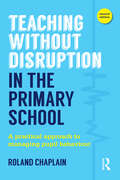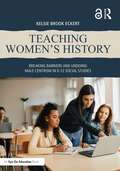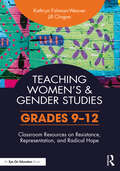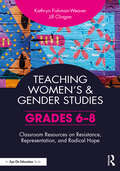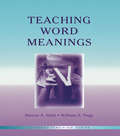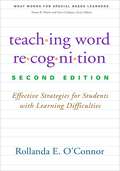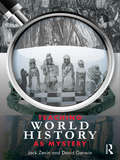- Table View
- List View
Teaching What Really Happened: How to Avoid the Tyranny of Textbooks and Get Students Excited About Doing History (Multicultural Education Series)
by James W. LoewenOur society needs engaged citizens now more than ever, and this bestseller offers concrete ideas for getting students excited about history while also teaching them to read critically. Among other updates, the second edition features a new chapter entitled "Truth" that addresses how traditional and social media can distort current events and the historical record.
Teaching What They Learn, Learning What They Live: How Teachers' Personal Histories Shape Their Professional Development
by Brad Olsen"Cogent, interesting, and provocative."-from the foreword by Ann Lieberman Teaching What They Learn, Learning What They Live explores the multiple social, political, and epistemological domains that comprise learning-to-teach. Based on a study of eight beginning English teachers at four different university teacher preparation programs, this book examines the ways in which beginning teachers' personal dispositions and conceptions combines with their teacher preparation programs' professional knowledge and contexts to form their understandings of and approaches toward teaching. Brad Olsen recasts learning-to-teach as a continuous, situated identity process in which prior experiences produce deeply embedded ways of viewing the world that go on to organize current/future experience into meaning. Since experience shapes learning and everyone acquires different sets of experience, no individual teacher's knowledge is exactly like another's. Yet Olsen shows also that the process by which a teacher constructs professional knowledge is common: the what of teacher knowledge varies, but the how remains the same.
Teaching What You Don’t Know
by Therese HustonYour graduate work was on bacterial evolution, but now you're lecturing to 200 freshmen on primate social life. You've taught Kant for twenty years, but now you're team-teaching a new course on “Ethics and the Internet.” The personality theorist retired and wasn't replaced, so now you, the neuroscientist, have to teach the "Sexual Identity" course. Everyone in academia knows it and no one likes to admit it: faculty often have to teach courses in areas they don't know very well. The challenges are even greater when students don't share your cultural background, lifestyle, or assumptions about how to behave in a classroom. In this practical and funny book, an experienced teaching consultant offers many creative strategies for dealing with typical problems. How can you prepare most efficiently for a new course in a new area? How do you look credible? And what do you do when you don't have a clue how to answer a question? Encouraging faculty to think of themselves as learners rather than as experts, Therese Huston points out that authority in the classroom doesn't come only, or even mostly, from perfect knowledge. She offers tips for introducing new topics in a lively style, for gauging students' understanding, for reaching unresponsive students, for maintaining discussions when they seem to stop dead, and -yes- for dealing with those impossible questions. Original, useful, and hopeful, this book reminds you that teaching what you don't know, to students whom you may not understand, is not just a job. It's an adventure.
Teaching What You're Not: Identity Politics in Higher Education
by Katherine J. MayberryExamines the roles of historical, cultural, and personal identities in the classroomCan whites teach African-American literature effectively and legitimately? What is at issue when a man teaches a women's studies course? How effectively can a straight woman educate students about gay and lesbian history? What are the political implications of the study of the colonizers by the colonized? More generally, how does the identity of an educator affect his or her credibility with students and with other educators? In incident after well-publicized incident, these abstract questions have turned up in America's classrooms and in national media, often trivialized as the latest example of PC excess. Going beyond simplistic headlines, Teaching What You're Not broaches these and many other difficult questions. With contributions from scholars in a variety of disciplines, the book examines the ways in which historical, cultural, and personal identities impact pedagogy and scholarship. Essays cover such topics as the outsider's gaze as it applies to the study of non-white literature; an able-bodied woman's reflections on teaching literature by disabled women; and the challenges of teaching the Western canon at an African American college.
Teaching What You're Not: Identity Politics in Higher Education (Open Access Lib And Hc Ser.)
by Katherine J. MayberryCan whites teach African-American literature effectively and legitimately? What is at issue when a man teaches a women's studies course? How effectively can a straight woman educate students about gay and lesbian history? What are the political implications of the study of the colonizers by the colonized? More generally, how does the identity of an educator affect his or her credibility with students and with other educators? In incident after well-publicized incident, these abstract questions have turned up in America's classrooms and in national media, often trivialized as the latest example of PC excess. Going beyond simplistic headlines, Teaching What You're Not broaches these and many other difficult questions. With contributions from scholars in a variety of disciplines, the book examines the ways in which historical, cultural, and personal identities impact on pedagogy and scholarship. Essays cover such topics as the outsider's gaze as it applies to the study of non-white literature; an able-bodied woman's reflections on teaching literature by disabled women; and the challenges of teaching the Western canon at an African American college.
Teaching When The World Is On Fire: Classroom Conversation In Challenging Times
by Lisa DelpitIs it okay to discuss politics in class? What are constructive ways to help young people process the daily news coverage of sexual assault? How can educators engage students around Black Lives Matter? Climate change? Confederate statue controversies? Immigration? Hate speech? <p><p> Lisa Delpit's Other People's Children, a classic text on cultural slippage in classrooms, has sold over a quarter million copies. In Teaching When the World Is on Fire, Delpit now turns to a host of crucial issues facing teachers in these tumultuous times. Delpit's master-teacher wisdom tees up guidance from beloved, well-known educators along with insight from dynamic principals and classroom teachers tackling difficult topics in K–12 schools every day. <p> This honest and rich collection brings together essential observations on safety from Pedro Noguera and Carla Shalaby; incisive ideas on traversing politics from William Ayers and Mica Pollock; Christopher Emdin's instructive views on respecting and connecting with black and brown students; Hazel Edwards's crucial insight about safe spaces for transgender and gender-nonconforming students; and James W. Loewen's sage suggestions about exploring symbols of the South; as well as timely thoughts from Bill Bigelow on teaching the climate crisis―and on the students and teachers fighting for environmental justice. <p> An energizing volume that speaks to our contentious world and the necessary conversations we all must have about it, Teaching When the World Is on Fire is sure to inspire teachers to support their students in navigating the current events, cultural shifts, and social dilemmas that shape our communities and our country.
Teaching Where You Are: Weaving Indigenous and Slow Principles and Pedagogies
by Lorrie Miller Shannon LeddyTeaching Where You Are offers a guide for non-Indigenous educators to work in good ways with Indigenous students and provides resources across curricular areas to support all students. In this book, two seasoned educators, one Indigenous and one settler, bring to bear their years of experience teaching in elementary, secondary, and post-secondary contexts to explore the ways in which Indigenous and Slow approaches to teaching and learning mirror and complement one another. Using the holistic framework of the Medicine Wheel, Shannon Leddy and Lorrie Miller illustrate the ways in which interdisciplinary thinking, a focus on experiential learning, and the thoughtful application of the 4Rs – Respect, Relevance, Reciprocity, and Responsibility – can bring us back to the principle of teaching people, not subjects. Bringing forth the ways in which colonialism and cognitive imperialism have shaped Canadian curriculum and consciousness, the book offers avenues for the development of decolonial literacy to support the work of Indigenizing education. In considering the importance of engaging in decolonizing and Indigenizing approaches to education through Slow and Indigenous pedagogies using the lens of place-based and land-based education, Teaching Where You Are presents a text useful for teachers and educators grappling with the ongoing impacts of colonialism and the soul-work of how to decolonize and rehumanize education in meaningful ways.
Teaching While Black: A New Voice on Race and Education in New York City
by Pamela LewisTeaching should never be color-blind. In a world where many believe the best approach toward eradicating racism is to feign ignorance of our palpable physical differences, a few have led the movement toward convincing fellow educators not only to consider race but to use it as the very basis of their teaching. This is what education activist and writer Pamela Lewis has set upon to do in her compelling book, Teaching While Black: A New Voice on Race and Education in New York City. As the title suggests, embracing blackness in the classroom can be threatening to many and thus challenging to carry out in the present school system.Unapologetic and gritty, Teaching While Black offers an insightful, honest portrayal of Lewis’s turbulent eleven-year relationship within the New York City public school system and her fight to survive in a profession that has undervalued her worth and her understanding of how children of color learn best. Tracing her educational journey with its roots in the North Bronx, Lewis paints a vivid, intimate picture of her battle to be heard in a system struggling to unlock the minds of the children it serves, while stifling the voices of teachers of color who hold the key. The reader gains full access to a perspective that has been virtually ignored since the No Child Left Behind Act, through which questions surrounding increased resignation rates by teachers of color and failing test scores can be answered. Teaching While Black is both a deeply personal narrative of a black woman’s real-life experiences and a clarion call for culturally responsive teaching. Lewis fearlessly addresses the reality of toxic school culture head-on and gives readers an inside look at the inert bureaucracy, heavy-handed administrators, and ineffective approach to pedagogy that prevent inner-city kids from learning. At the heart of Lewis’s moving narrative is her passion. Each chapter delves deeper into the author’s conscious uncoupling from the current trends in public education that diminish proven remedies for academic underachievement, as observed from her own experiences as a teacher of students of color. Teaching While Black summons everyone to re-examine what good teaching looks like. Through a powerful vision, together with practical ideas and strategies for teachers navigating very difficult waters, Lewis delivers hope for the future of teaching and learning in inner-city schools.
Teaching White Supremacy: America's Democratic Ordeal and the Forging of Our National Identity
by Donald YacovoneA powerful exploration of the past and present arc of America&’s white supremacy—from the country&’s inception and Revolutionary years to its 19th century flashpoint of civil war; to the Civil Rights movement of the 1960s and today&’s Black Lives Matter. &“The most profoundly original cultural history in recent memory.&” —Henry Louis Gates, Jr., Harvard University&“Stunning, timely . . . an achievement in writing public history . . . Teaching White Supremacy should be read widely in our roiling debate over how to teach about race and slavery in classrooms." —David W. Blight, Sterling Professor of American History, Yale University; author of the Pulitzer Prize–winning Frederick Douglass: Prophet of Freedom Donald Yacovone shows us the clear and damning evidence of white supremacy&’s deep-seated roots in our nation&’s educational system through a fascinating, in-depth examination of America&’s wide assortment of texts, from primary readers to college textbooks, from popular histories to the most influential academic scholarship. Sifting through a wealth of materials from the colonial era to today, Yacovone reveals the systematic ways in which this ideology has infiltrated all aspects of American culture and how it has been at the heart of our collective national identity. Yacovone lays out the arc of America&’s white supremacy from the country&’s inception and Revolutionary War years to its nineteenth-century flashpoint of civil war to the civil rights movement of the 1960s and today&’s Black Lives Matter. In a stunning reappraisal, the author argues that it is the North, not the South, that bears the greater responsibility for creating the dominant strain of race theory, which has been inculcated throughout the culture and in school textbooks that restricted and repressed African Americans and other minorities, even as Northerners blamed the South for its legacy of slavery, segregation, and racial injustice. A major assessment of how we got to where we are today, of how white supremacy has suffused every area of American learning, from literature and science to religion, medicine, and law, and why this kind of thinking has so insidiously endured for more than three centuries.
Teaching With Author Web Sites, K–8
by Mark L. Gura Rose C. ReissmanInviting students and teachers into a fascinating literary community, this innovative guide helps teachers use the Web sites of favorite children's book authors to deepen student engagement in learning.
Teaching With Love And Logic: Taking Control Of The Classroom
by Jim Fay Charles FayThe exercises and tips contained in this book will help teachers orient students toward being internalized in their discipline rather than depending upon external controls--resulting in easier classroom management and more quality teaching time. Jim and Charles Fay will teach you how to effectively manage your classroom through shared control, choices within limits and the importance of relationships. For teachers in grades K-12.
Teaching With Poverty In Mind: What Being Poor Does To Kids' Brains and What Schools Can Do About It
by Eric JensenIn this book, veteran educator and brain expert Eric Jensen takes an unflinching look at how poverty hurts children, families, and communities across the United States and demonstrates how schools can improve the academic achievement and life readiness of economically disadvantaged students. Jensen argues that although chronic exposure to poverty can result in detrimental changes to the brain, the brain's very ability to adapt from experience means that poor children can also experience emotional, social, and academic success. A brain that is susceptible to adverse environmental effects is equally susceptible to the positive effects of rich, balanced learning environments and caring relationships that build students' resilience, self-esteem, and character. Drawing from research, experience, and real school success stories, Teaching with Poverty in Mind reveals: - What poverty is and how it affects students in school. - What drives change both at the macro level (within schools and districts) and at the micro level (inside a student's brain)? - Effective strategies from those who have succeeded and ways to replicate those best practices at your own school. - How to engage the resources necessary to make change happen? Too often, we talk about change while maintaining a culture of excuses. We can do better. Although no magic bullet can offset the grave challenges faced daily by disadvantaged children, this timely resource shines a spotlight on what matters most, providing an inspiring and practical guide for enriching the minds and lives of all your students.
Teaching With Superpowers: Ten Brain-Informed Practices
by C. Bobbi HansenUnleash your inner teaching superhero Incorporating the principles of neuroscience not only transforms the practices that take place in the classroom, but also empowers teachers, equipping them with the tools they need to feel and be successful in their work. Written in a lighthearted, easy-to-read format, author C. Bobbi Hansen showcases the potential of brain-informed practices to empower teachers and learners alike. By centering instructional practices on research from the field of educational neuroscience, Teaching With Superpowers identifies ten "superpowers" that teachers can activate to optimize how their students’ brains take in, process, and store information. Inside you’ll find: How to optimize teaching and learning by understanding the science of how students learn 10 unique "superpowers" that will enhance your students’ learning, including fueling attention and engagement, promoting culturally responsive teaching, boosting long-term memory, and championing neurodiversity Numerous classroom examples and resources applicable to any content area or grade level For all educators who are passionate about helping their students succeed and maximizing their teaching potential, this is your essential guide.
Teaching With Superpowers: Ten Brain-Informed Practices
by C. Bobbi HansenUnleash your inner teaching superhero Incorporating the principles of neuroscience not only transforms the practices that take place in the classroom, but also empowers teachers, equipping them with the tools they need to feel and be successful in their work. Written in a lighthearted, easy-to-read format, author C. Bobbi Hansen showcases the potential of brain-informed practices to empower teachers and learners alike. By centering instructional practices on research from the field of educational neuroscience, Teaching With Superpowers identifies ten "superpowers" that teachers can activate to optimize how their students’ brains take in, process, and store information. Inside you’ll find: How to optimize teaching and learning by understanding the science of how students learn 10 unique "superpowers" that will enhance your students’ learning, including fueling attention and engagement, promoting culturally responsive teaching, boosting long-term memory, and championing neurodiversity Numerous classroom examples and resources applicable to any content area or grade level For all educators who are passionate about helping their students succeed and maximizing their teaching potential, this is your essential guide.
Teaching With Text-Based Questions: Helping Students Analyze Nonfiction and Visual Texts
by Kevin Thomas SmithHelp your students navigate complex texts in history/social studies and English language arts! This book shows you how to use a key tool—text-based questions—to build students’ literacy and critical thinking skills and meet the Common Core State Standards. You’ll learn how to ask text-based questions about different types of nonfiction and visual texts, including primary and secondary sources, maps, charts, and paintings. You’ll also get ideas for teaching students to examine point of view, write analytical responses, compare texts, cite textual evidence, and pose their own high-level questions. The book is filled with examples that you can use immediately or modify as needed. Each chapter ends with a reflection section to help you adapt the ideas to your own classroom. What’s Inside: Helpful information on teaching different types of nonfiction texts, including literary nonfiction, informational texts, primary and secondary sources, and visual texts Ideas for locating primary sources Questions students should ask about every text Techniques for soliciting higher-order questions from students Ways to get students to think critically about the relationships between texts Strategies to help students integrate information from different types of sources, a skill that will help students respond to performance tasks on the PARCC and SBAC assessments and DBQs on AP exams Tips for teaching students to write good responses to text-based questions, including how to cite sources and incorporate point of view Ideas for using rubrics and peer grading to evaluate students’ responses Connections to the informational reading standards of the Common Core State Standards for English Language Arts for grades 3-12 and of the Common Core State Standards for Literacy in History/Social Studies, Science, and Technical Subjects
Teaching With the Tools Kids Really Use: Learning With Web and Mobile Technologies
by Susan J. Brooks-YoungA foundational guide for integrating mobile technologies into your classroom! Designed to help educators deliver relevant instruction through the use of 21st-century technologies, this resource examines available low-cost hardware, explores free Web 2.0 tools, and sheds light on the pros and cons of using mobile technologies for instructional support. Emphasizing the ethical use of technology, the book identifies: Specific Web 2.0 options for supporting collaboration and communication in K–12 settings; Strategies for practical applications; A decision-making model for selecting appropriate mobile technologies and Web 2.0 tools for classroom use; Recommended books, Web sites, and online reports and articles for reference.
Teaching Without Bells: What We Can Learn from Powerful Practice in Small Schools (Teacher's Toolkit Ser.)
by Joey FeldmanSmall schools have the potential to fundamentally change the conditions of teaching and learning when practitioners deliberately exploit smallness and recognize relationships as a powerful mechanism for improving student achievement. Feldman explains the dynamics of teaching in a small high school--what having fewer students in a school affords teachers, as well as the challenges for teaching that exist alongside the opportunities--based on research, teacher interviews, and the author's own experiences as a practitioner in both small and large schools. This book is for any educator or researcher who wants to better understand the kind of promising practices and professional norms that have been nurtured under conditions of smallness. Being informed about what is possible and often facilitated in small schools will enable educators to better reflect on their own practice, consider certain pedagogical strategies against the organizational characteristics of schools, and make educated career choices. Armed with this information, educators and researchers can become more focused in their advocacy efforts and more empowered to improve our public high schools whether by redesigning them into small schools or by transplanting and translating small school practices and strategies."
Teaching Without Disruption in the Primary School: A practical approach to managing pupil behaviour
by Roland ChaplainThe issue of behaviour has, and always will be, a main dilemma facing schools. Encouraging positive relationships whilst preventing disruption, and motivating students to learn, raises concerns for any teacher. This fully updated second edition of Teaching without Disruption in the Primary School offers a comprehensive and constructive approach to developing effective behaviour management. Packed full of tasks, case studies, and research-based guidance, this extremely practical book reflects high quality behaviour management training and is crucially informed by empirical evidence on exactly what works in classrooms and schools. Containing two brand new chapters - one on the importance of theory in developing effective behaviour management, and the other detailing a toolkit for constructing effective classroom management plans - the book presents a model for developing: effective behaviour management at the individual pupil, classroom and whole school level professional social skills, assertiveness and coping strategies understanding of how teachers’ thinking and behaviour can unwittingly affect pupil behaviour a roadmap for establishing and maintaining authority pupils’ self-control and social competence using a cognitive-behavioural approach an appreciation of the value of adopting a research-based approach to behaviour management. Roland Chaplain has used this programme to successfully teach behaviour management techniques to thousands of PGCE trainees at the University of Cambridge, UK. Underpinned by contemporary educational, psychological and neuroscientific research, this book offers a progressively focused behaviour management model which will appeal to all teachers and teacher trainees, as well as to those who train them.
Teaching Women's History: Breaking Barriers and Undoing Male Centrism in K-12 Social Studies
by Kelsie Brook EckertTeaching Women’s History: Breaking Barriers and Undoing Male Centrism in K-12 Social Studies challenges and guides K-12 history teachers to incorporate comprehensive and diverse women’s history into every region and era of their history curriculum.Providing a wealth of practical examples, ideas, and lesson plans – all backed by scholarly research – for secondary and middle school classes, this book demonstrates how teachers can weave women’s history into their curriculum today. It breaks down how history is taught currently, how teachers are prepared, and what expectations are set in state standards and textbooks and then shows how teachers can use pedagogical approaches to better incorporate women’s voices into each of these realms. Each chapter explores a major barrier to teaching an inclusive history and how to overcome it, and every chapter ends with an inquiry-based lesson plan on women or using women's sources which stands counter to the way curriculum is traditionally taught, a case in point that tasks readers to realize how women have been integral to every period of history.With expert guidance from an award-winning social studies teacher, this guidebook will be important reading for middle and high school history educators. It will also be beneficial to preservice teachers, particularly within Social Studies Education and Gender Studies.Additional resources for educators are available to view at www.remedialherstory.com.
Teaching Women's and Gender Studies: Classroom Resources on Resistance, Representation, and Radical Hope (Grades 9-12)
by Kathryn Fishman-Weaver Jill ClinganIncorporate women’s and gender studies into your high school classroom using the powerful lesson plans in this book. The authors present seven units organized around four key concepts: Why WGST; Intersectionality; Motherland—History, Health, and Policy Change; and Artivism. With thought questions for activating prior knowledge, teaching notes, reflection questions, reproducibles, and strategies, these units are ready to integrate purposefully into your existing classroom practice. Across various subject areas and interdisciplinary courses, these lessons help to fill a critical gap in the curriculum. Through affirming, inclusive, and representative projects, this book offers actionable ways to encourage and support young people as they become changemakers for justice. This book is part of a series on teaching Women’s and Gender Studies in the K-12 classroom. We encourage readers to also check out the middle school edition.
Teaching Women’s and Gender Studies: Classroom Resources on Resistance, Representation, and Radical Hope (Grades 6-8)
by Kathryn Fishman-Weaver Jill ClinganIncorporate Women’s and Gender Studies into your middle school classroom using the powerful lesson plans in this book. The authors present seven units organized around four key concepts: Why WGST; Art, Emotion, and Resistance; Diversity, Inclusion, and Representation; and Intersectionality. With thought questions for activating prior knowledge, teaching notes, reflection questions, reproducibles, and strategies, these units are ready to integrate purposefully into your existing classroom practice. Across various subject areas and interdisciplinary courses, these lessons help to fill a critical gap in the curriculum. Through affirming, inclusive, and representative projects, this book offers actionable ways to encourage and support young people as they become changemakers for justice. This book is part of a series on teaching Women’s and Gender Studies in the K-12 classroom. We encourage readers to also check out the high school edition.
Teaching Word Meanings (Literacy Teaching Series)
by Steven A. Stahl William E. NagyLearning new words is foundational to success in school and life. Researchers have known for years that how many word meanings a student knows is one of the strongest predictors of how well that student will understand text and be able to communicate through writing. This book is about how children learn the meanings of new words (and the concepts they convey) and how teachers can be strategic in deciding which words to teach, how to teach them, and which words not to teach at all.This book offers a comprehensive approach to vocabulary instruction. It offers not just practical classroom activities for teaching words (though plenty of those are included), but ways that teachers can make the entire curriculum more effective at promoting students' vocabulary growth. It covers the 'why to' and 'when to' as well as the 'how to' of teaching word meanings.Key features of this exciting new book include:*A variety of vocabulary activities. Activities for teaching different kinds of words such as high frequency words, high utility words, and new concepts, are explained and illustrated.*Guidelines for choosing words. A chart provides a simple framework built around seven basic categories of words that helps teachers decide which words to teach and how to teach them.*Word learning strategies. Strategies are offered that will help students use context, word parts, and dictionaries more effectively.*Developing Word Consciousness. Although specific vocabulary instruction is fully covered, the primary goal of this book is to develop students' independent interest in words and their motivation to learn them.*Integrated Vocabulary Instruction. Teachers are encouraged to improve the reading vocabularies of their students by looking for opportunities to integrate vocabulary learning into activities that are undertaken for other purposes.
Teaching Word Recognition, Second Edition: Effective Strategies for Students with Learning Difficulties (What Works for Special-Needs Learners)
by Rollanda E. O'ConnorThis highly regarded teacher resource synthesizes the research base on word recognition and translates it into step-by-step instructional strategies, with special attention to students who are struggling. Chapters follow the stages through which students progress as they work toward skilled reading of words. Presented are practical, evidence-based techniques and activities that target letter- sound pairings, decoding and blending, sight words, multisyllabic words, and fluency. Ideal for use in primary-grade classrooms, the book also offers specific guidance for working with older children who are having difficulties. Reproducible assessment tools and word lists can be downloaded and printed in a convenient 8 1/2" x 11" size. New to This Edition *Incorporates the latest research on word recognition and its connections to vocabulary, reading fluency, and comprehension. *Chapter on morphological (meaning-based) instruction. *Chapter on English language learners. *Instructive "Try This" activities at the end of each chapter for teacher study groups and professional development.
Teaching World Epics (Options for Teaching)
by Jo Ann CavalloCultures across the globe have embraced epics: stories of memorable deeds by heroic characters whose actions have significant consequences for their lives and their communities. Incorporating narrative elements also found in sacred history, chronicle, saga, legend, romance, myth, folklore, and the novel, epics throughout history have both animated the imagination and encouraged reflection on what it means to be human. Teaching World Epics addresses ancient and more recent epic works from Africa, Europe, Mesoamerica, and East, Central, and South Asia that are available in English translations.Useful to instructors of literature, peace and conflict studies, transnational studies, women's studies, and religious studies, the essays in this volume focus on epics in sociopolitical and cultural contexts, on the adaptation and reception of epic works, and on themes that are especially relevant today, such as gender dynamics and politics, national identity, colonialism and imperialism, violence, and war.This volume includes discussion of Ludovico Ariosto's Orlando Furioso, Giulia Bigolina's Urania, The Book of Dede Korkut, Luís Vaz de Camões's Os Lusíadas, David of Sassoun, The Epic of Askia Mohammed, The Epic of Gilgamesh, the epic of Sun-Jata, Alonso de Ercilla y Zúñiga's La Araucana, Homer's Iliad and Odyssey, Kalevala, Kebra Nagast, Kudrun, The Legend of Poṉṉivaḷa Nadu, the Mahabharata, Manas, John Milton's Paradise Lost, Mwindo, the Nibelungenlied, Poema de mio Cid, Popol Wuj, the Ramayana, the Shahnameh, Sirat Bani Hilal, Edmund Spenser's The Faerie Queene, Statius's Thebaid, The Tale of the Heike, Three Kingdoms, Gaspar Pérez de Villagrá's Historia de la Nueva México, and Virgil's Aeneid.
Teaching World History as Mystery
by David Gerwin Jack ZevinOffering a philosophy, methodology, and examples for history instruction that are active, imaginative, and provocative, this text presents a fully developed pedagogy based on problem-solving methods that promote reasoning and judgment and restore a sense of imagination and participation to classroom learning. It is designed to draw readers into the detective process that characterizes the work of professional historians and social scientists ? sharing raw data, defining terms, building interpretations, and testing competing theories. An inquiry framework drives both the pedagogy and the choice of historical materials, with selections favoring the unsolved, controversial, and fragmented rather than the neatly wrapped up analysis of past events. Teaching World History as Mystery: Provides a balanced combination of interestingly arranged historical content, and clearly explained instructional strategies Features case studies of commonly and not so commonly taught topics within a typical world/global history curriculum using combinations of primary and secondary documents Discusses ways of dealing with ethical and moral issues in world history classrooms, drawing students into persisting questions of historical truth, bias, and judgment

